Nikon 1 Nikkor 10mm f/2.8 Review
-
Ease
of Use -
Sample
Images -
Lens
Specs -
Rating &
Conclusion -
Main
Rivals -
Review
Roundup - Comment
-
More…

Introduction
The Nikon 1 Nikkor 10mm f/2.8 is a wide-angle pancake lens for the new Nikon 1 system. Constructed of six elements in five groups with two aspherical lens elements, the Nikon 1 Nikkor 10mm f/2.8 VR features an iris diaphragm with seven rounded blades, manual focus operation via the camera body controls, metal lens mount, 41mm filter thread and a stepping (STM) motor for super-quiet autofocus performance. With a 35mm equivalent focal range of approximately 27mm, the Nikon 1 Nikkor 10mm f/2.8 has an extremely compact and lightweight construction for superior portability. The lens is available in four colours - black, white, silver and red, in a kit with the Nikon 1 V1 and Nikon 1 J1 cameras, or separately for £229.99 / $249.95.
Ease of Use
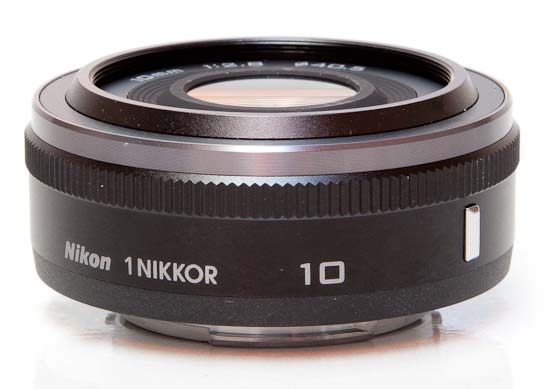 The 1 Nikkor 10mm lens
The 1 Nikkor 10mm lens
The Nikon 1 Nikkor 10mm f/2.8 is among the very first lenses announced for the brand new Nikon 1 system, which is built around a so-called CX format sensor that's considerably smaller than a regular Four Thirds imager. Weighing in at a mere 77 grams and measuring just 55.5x22mm, the 1 Nikkor 10mm lens is a very small and light lens indeed.
 The front of the 1 Nikkor 10mm lens
The front of the 1 Nikkor 10mm lens
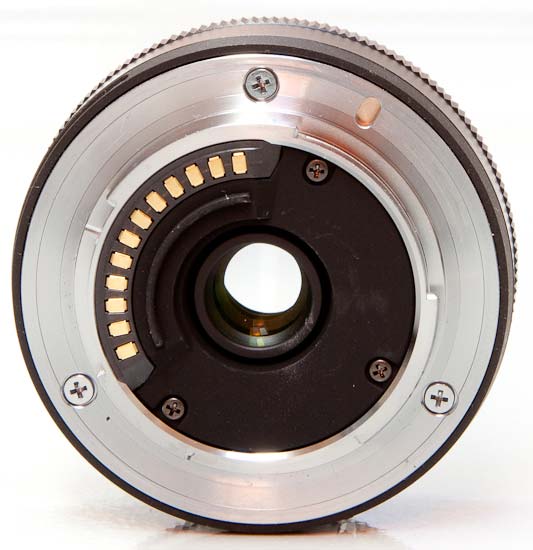 The rear of the 1 Nikkor 10mm lens
The rear of the 1 Nikkor 10mm lens
Build quality is excellent, with the lens feeling surprisingly solid for its size and price tag.
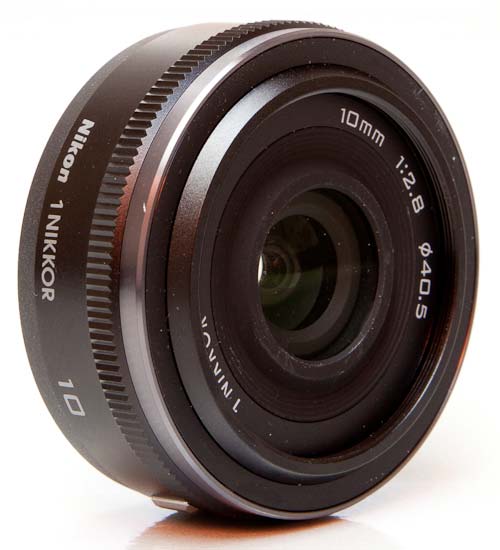 The front of the 1 Nikkor 10mm lens, isometric view
The front of the 1 Nikkor 10mm lens, isometric view
In terms of features, the Nikon 1 Nikkor 10mm f/2.8 VR is a rather unusual offering. There is no focus ring, and no focus mode switch either. Switching between AF and MF is instead done via the camera's user interface, and you need to use the camera's rear-mounted scroll wheel to focus the lens manually, which may be unusual if you're used to SLR lenses. Note that it doesn't have built-in Vibration Reduction either.
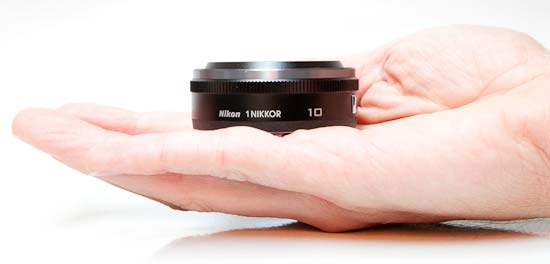 The 1 Nikkor 10mm lens, in-hand
The 1 Nikkor 10mm lens, in-hand
The Nikon 1 Nikkor 10mm f2.8 lens takes small 47mm filters and ships with a tiny snap-on lens and rear caps. Given its diminutive size, it easily fits into a coat pocket or any photo bag. If you want added protection, Nikon will be happy to sell you the optional CL-N101 soft case, and there's also a lens hood (HN-N101) and hood cap (HC-N101) available too.
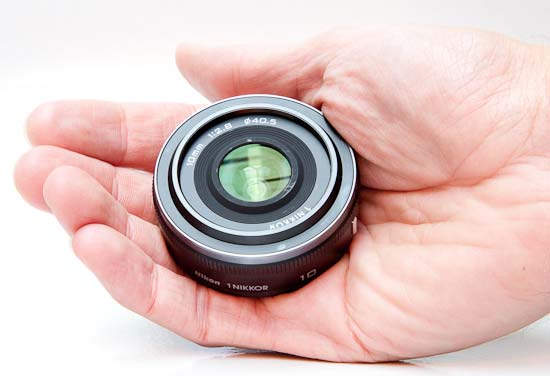 The 1 Nikkor 10mm lens, in-hand
The 1 Nikkor 10mm lens, in-hand
The lens is outfitted with a solid metal bayonet mount and a dozen electrical contacts that provide 100% electronic communication with the camera body.
Focal Range
Due to the 2.72x “crop factor” of the Nikon CX sensor the lens has been designed for, the Nikon 1 Nikkor 10mm f2.8 has a 35mm equivalent focal range of 27mm and the angle of view is 77°.
 Field of view at 10mm
Field of view at 10mm
Focusing
One of the biggest claims Nikon has made about the 1 System was that it has the fastest AF in the world. Now, we've heard that claim before from other companies so we were naturally curious to find out how this particular lens behaved in this respect. We're pleased to report that in good light, the 1 Nikkor 10mm lens, mounted to a Nikon 1 V1 body, does indeed focus extremely quickly, and not just on stationary subjects. With the focus mode set to continuous AF, the combo has a remarkable capability of keeping fast-moving subjects in focus, even during burst shooting (as long as you do not set a frame rate that's faster than 10fps on the camera, that is).
In low light, the 1 System cameras will resort to contrast-detect auto focus. This focusing method is slower than the phase-difference detection used in good light, so do not expect the lens to achieve the same level of performance. Low-light shooting pretty much requires your subject to stand still.
As mentioned above, manual focusing is also possible, even though the lens does not have a focus ring. To focus manually, you first need to set the focus mode to MF on the camera, then use the scroll wheel for focusing. This isn't the most intuitive method and you will likely to find it strange if you're coming from the SLR world. Also, while the camera offers a magnified display to aid you with getting the focus right, the magnification seems interpolated and is thus a lot less helpful than it could be with a better implementation.
Chromatic Aberrations
Chromatic aberrations, typically seen as purple or blue fringes along contrasty edges, are basically a non-issue with this lens. There's only a hint of CA along contrasty edges, which is not field relevant at all.
 |
 |
Macro
The Nikon 1 Nikkor 10mm f/2.8 VR is not really a macro lens, but the minimum focus distance is a respectable enough 0.2m, and the maximum reproduction ratio is 1:16. The following example demonstrates how close you can get to your subject, in this case a SD memory card.
 Close-up performance
Close-up performance
Bokeh
Bokeh is a word used for the out-of-focus areas of a photograph, and is usually described in qualitative terms, such as smooth / creamy / harsh etc. In the 1 Nikkor 10mm f/2.8, Nikon emplyed an iris diaphragm with 7 rounded blades for a smooth bokeh. We have found that when you can throw the background sufficiently out of focus, the lens does indeed produce a pleasing bokeh but your subject needs to be quite close and the background quite far away for that. Otherwise the result can be a little “nervous” for our tastes.
 |
 |
Sharpness
In order to show you how sharp this lens is, we are providing 100% crops on the following pages.
-
Ease
of Use -
Sample
Images -
Lens
Specs -
Rating &
Conclusion -
Main
Rivals -
Review
Roundup - Comment
